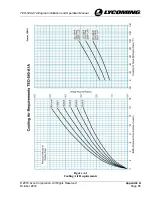
© 2018 Avco Corporation. All Rights Reserved
Engine Conditions
October 2018
Page 71
TEO-540-A1A Engine Installation and Operation Manual
Table 1 (Cont.)
Action for Engine Conditions
Engine Condition
Explanation/Corrective Action
Engine Operation (Cont.)
Engine indication not available
Complete a safe landing and speak to Maintenance.
Engine in an environment at
temperatures less than 10°F
(-12°C) for more than 2 hours
Refer to the section “Apply Heat to a Cold Engine” in
this chapter.
Operation in climates above 100°F
(38°C)
Decrease climb angles to keep the engine cool. Refer to
the section “Engine Operation in Hot Weather” in this
chapter.
Fuel consumption fluctuation
The EECS controls fuel flow to the engine based on the
actual airflow through the engine. The engine will
consume more air on a cold day than on a hot day for the
same rpm and manifold pressure. The EECS controls fuel
flow to maintain the desired fuel-to-air ratio.
Fuel flow rate and lean of peak
operation
The optimum fuel flow for a given combination of air
intake and engine speed conditions has been pre-
calculated. This optimal fuel flow will enable both
economy and safe reliable operation. There could be
some select points where “Lean of Peak” operation is
advantageous.
Ascent to target altitude, leveled
off - fuel flow increased with
power control input
On hot days, during steep climbs, or in other situations in
which the engine could operate at high temperatures, the
EECS automatically prevents overheating. Higher fuel
flow can be observed as the EECS uses more fuel to
prevent detonation or exceeding the CHT or TIT limits.
Alternator or electrical system
fails in flight
The engine will continue to operate even if the alternator
or electrical system fails. The engine has a dedicated
electrical generator that is separate from airframe power
to ensure the engine continues to operate if external
power is not available. This power source will supply
power to the dedicated warning annunciators. In flight,
the engine can restart even without airframe power as
long as the engine is wind milling at least 1000 rpm.
Dead airframe battery on the
ground
Use a battery charger or jumper cart to start the engine.
Cannot operate low or high
manifold pressures at a specific
rpm
The EECS automatically uses a manifold pressure and
rpm combination depending on the throttle position. This
setting was calculated by the airframe manufacturer and
Lycoming for the most consistent operating points for
take-off, climb, and cruise.
















































